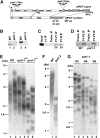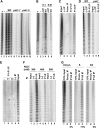Arabidopsis POT1 associates with the telomerase RNP and is required for telomere maintenance
- PMID: 17627276
- PMCID: PMC1949013
- DOI: 10.1038/sj.emboj.7601792
Arabidopsis POT1 associates with the telomerase RNP and is required for telomere maintenance
Abstract
POT1 is a single-copy gene in yeast and humans that encodes a single-strand telomere binding protein required for chromosome end protection and telomere length regulation. In contrast, Arabidopsis harbors multiple, divergent POT-like genes that bear signature N-terminal OB-fold motifs, but otherwise share limited sequence similarity. Here, we report that plants null for AtPOT1 show no telomere deprotection phenotype, but rather exhibit progressive loss of telomeric DNA. Genetic analysis indicates that AtPOT1 acts in the same pathway as telomerase. In vitro levels of telomerase activity in pot1 mutants are significantly reduced and are more variable than wild-type. Consistent with this observation, AtPOT1 physically associates with active telomerase particles. Although low levels of AtPOT1 can be detected at telomeres in unsynchronized cells and in cells arrested in G2, AtPOT1 binding is significantly enhanced during S-phase, when telomerase is thought to act at telomeres. Our findings indicate that AtPOT1 is a novel accessory factor for telomerase required for positive telomere length regulation, and they underscore the coordinate and extraordinarily rapid evolution of telomere proteins and the telomerase enzyme.
Figures





Similar articles
-
The Arabidopsis Pot1 and Pot2 proteins function in telomere length homeostasis and chromosome end protection.Mol Cell Biol. 2005 Sep;25(17):7725-33. doi: 10.1128/MCB.25.17.7725-7733.2005. Mol Cell Biol. 2005. PMID: 16107718 Free PMC article.
-
Alternative splicing of Pot1 (Protection of telomere)-like genes in Arabidopsis thaliana.Genes Genet Syst. 2005 Feb;80(1):41-8. doi: 10.1266/ggs.80.41. Genes Genet Syst. 2005. PMID: 15824455
-
Recent emergence and extinction of the protection of telomeres 1c gene in Arabidopsis thaliana.Plant Cell Rep. 2019 Sep;38(9):1081-1097. doi: 10.1007/s00299-019-02427-9. Epub 2019 May 27. Plant Cell Rep. 2019. PMID: 31134349 Free PMC article.
-
Regulation of telomerase by telomeric proteins.Annu Rev Biochem. 2004;73:177-208. doi: 10.1146/annurev.biochem.73.071403.160049. Annu Rev Biochem. 2004. PMID: 15189140 Review.
-
Protection against chromosome degradation at the telomeres.Biochimie. 2008 Jan;90(1):41-59. doi: 10.1016/j.biochi.2007.07.008. Epub 2007 Jul 24. Biochimie. 2008. PMID: 17764802 Review.
Cited by
-
tRNA ADENOSINE DEAMINASE 3 is required for telomere maintenance in Arabidopsis thaliana.Plant Cell Rep. 2020 Dec;39(12):1669-1685. doi: 10.1007/s00299-020-02594-0. Epub 2020 Sep 21. Plant Cell Rep. 2020. PMID: 32959123 Free PMC article.
-
Plant telomere biology: The green solution to the end-replication problem.Plant Cell. 2022 Jul 4;34(7):2492-2504. doi: 10.1093/plcell/koac122. Plant Cell. 2022. PMID: 35511166 Free PMC article.
-
How telomeric protein POT1 avoids RNA to achieve specificity for single-stranded DNA.Proc Natl Acad Sci U S A. 2010 Jan 12;107(2):651-6. doi: 10.1073/pnas.0911099107. Epub 2009 Dec 22. Proc Natl Acad Sci U S A. 2010. PMID: 20080730 Free PMC article.
-
Dyskerin is a component of the Arabidopsis telomerase RNP required for telomere maintenance.Mol Cell Biol. 2008 Apr;28(7):2332-41. doi: 10.1128/MCB.01490-07. Epub 2008 Jan 22. Mol Cell Biol. 2008. PMID: 18212040 Free PMC article.
-
Telomere stability and development of ctc1 mutants are rescued by inhibition of EJ recombination pathways in a telomerase-dependent manner.Nucleic Acids Res. 2014 Oct 29;42(19):11979-91. doi: 10.1093/nar/gku897. Epub 2014 Oct 1. Nucleic Acids Res. 2014. PMID: 25274733 Free PMC article.
References
Publication types
MeSH terms
Substances
Grants and funding
LinkOut - more resources
Full Text Sources
Molecular Biology Databases
Miscellaneous

